Ildiri was originally known as Erythrai (Greek “ερυθρός – erythrós” meaning “red”) given by settlers from Crete. After the 11th century, it was known as Erythrae, Erythra and Erythre; after the 14th century, it was also known as Rhtyrai, Lythri, Lithri, Lithra; and after the 16th century İlderen, Yeldiri, Ildir and Ildiri, while still known by Greek residents as Lithri up until 1922.
Getting there: 25km northeast of Çeşme town centre along the coast beyond Ilıca and Şifne. A 35-minute drive by car, or approximately 1 hour by dolmuş directly every 30-minutes from Çeşme centre. Dolmuş and buses also run to Izmir from Ildiri village. Map location: Yalı, 35930 Çeşme/İzmir entrance to the main archaeological site is from Heroon.
Access: Tickets ₺0.00 – currently no ticket required, open site 24/7 no visit time limitations.
Ildiri Archaeological Site
Today Ildiri is a small rural/tourist coastal village prominent as the site of the ancient Greek city ruins of Erythrai, which are mainly to be seen on the 88-metre hill (acropolis) above the village. These include the ruins of the podium walls of the 6th century B.C. Temple of Athena Polias and the 19th century Saint Matrona Church on the acropolis, the Heroon Temple today forms the entrance to the archaeological sites and the partially restored early 3rd century B.C. amphitheatre. In the fields to the north of the Heroon Temple and village are the foundations of Hellenistic and Roman houses and the more visible parts of the 5 kilometres of walls dating to the 3rd century B.C. To the south of the village near the seafront are the Roman Quarter mosaic excavations of the Cennettepe.
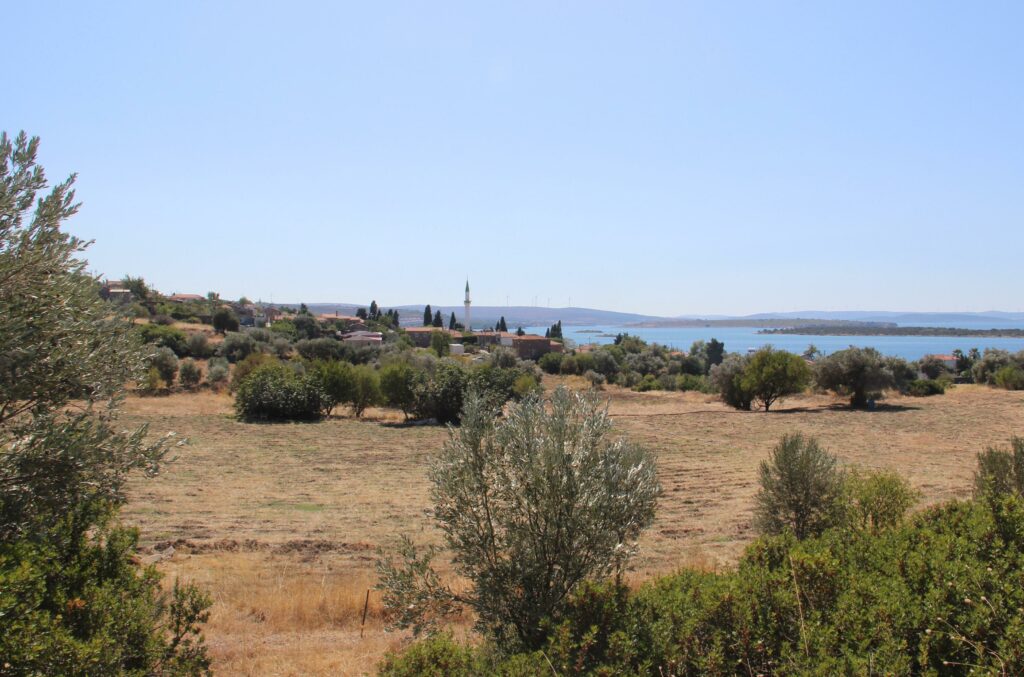
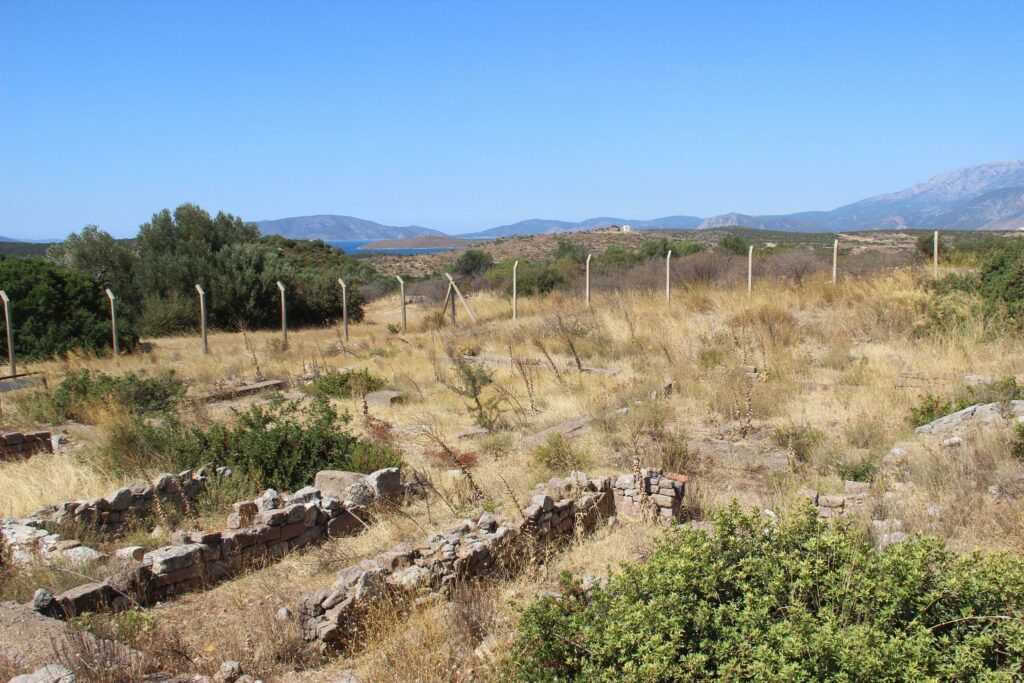

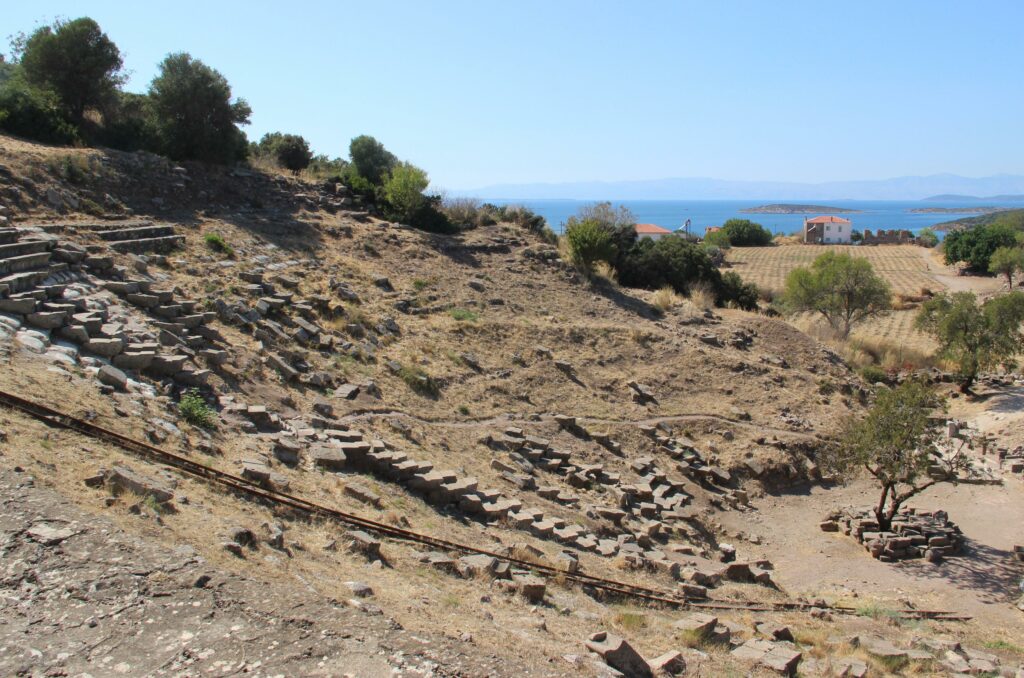
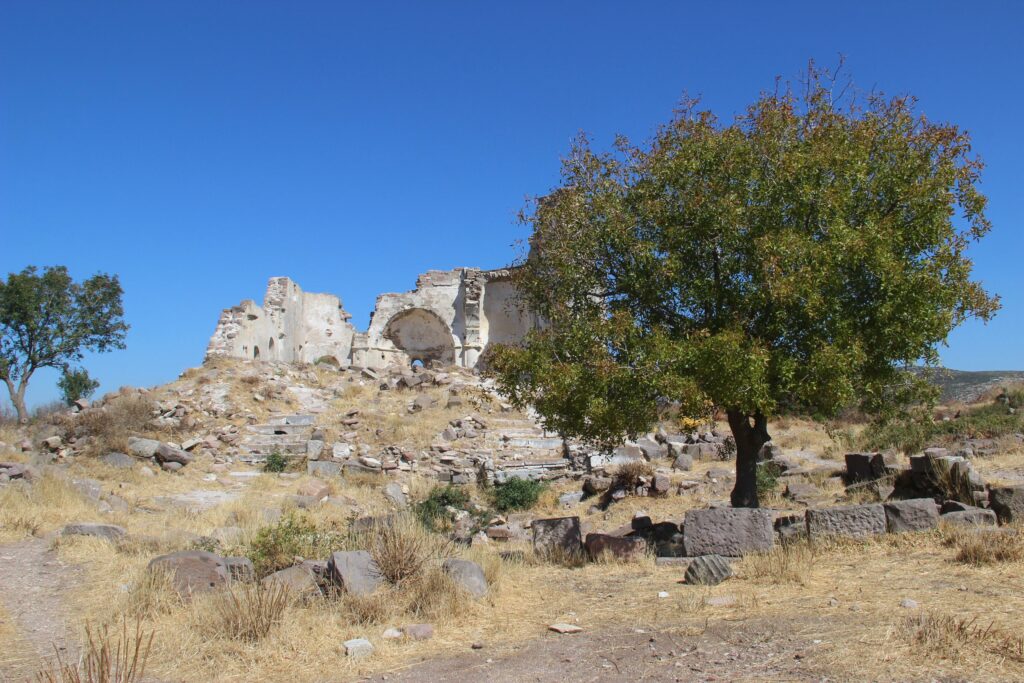
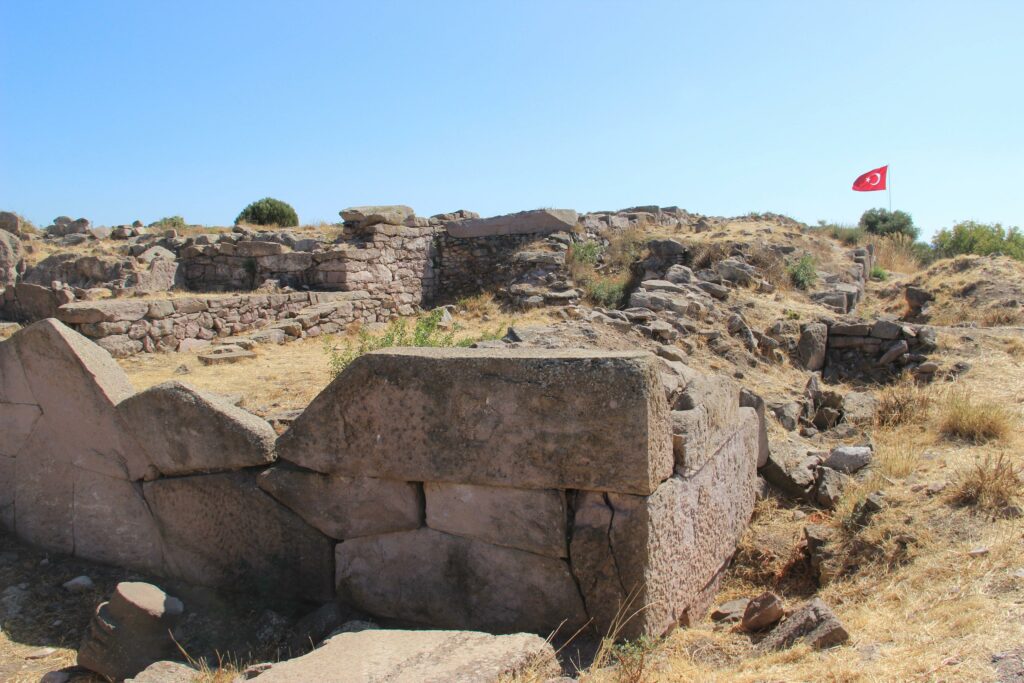
Short History of Erythrai and its Excavations
Extract of site explanation texts on the entrance to the site:
“Excavations in the ancient city of Erythrai commenced in 1964 under the directorship of Ord. Prof. Dr Ekrem Akurgal, one of the founders of the Archaeology Department of Ankara University, and Hakkı Gültekin, then the director of the Izmir Museum, with an aim of understanding Ionian culture and history. Excavations continued under the directorship of Prof. Dr Cevdet Bayburtluoğlu in the 1970s, and since 2006, with the permission of the Council of Ministers, excavations have re-started under the directorship of Ass. Prof. Dr Ayşe Gül Akalin-Orbay of Ankara University.
According to Hellenistic mythology, Erythrai was founded by the Cretan leader “Erythros”, literally meaning “red”. Afterwards
Erythrai, from the Archaic period onwards, was using eastern goods and acting as a market (Emporio) by distributing them to Ionian cities, and it can be observed that both in trade and diplomacy, it was a rival to Chios. A sacred area dedicated to Herakles, a god with an Eastern background, further indicates the connections with the East regarding religious aspects. After 546 B.C., with the advantage of being a harbour site during Persian rule, the city had intense relations with mainland Greece. It later became one of the influential members of the Delian League at the beginning of the 5th century B.C. From 330 B.C. onwards, the territory was ruled by Alexander the Great. Construction of the city’s fortification walls, which were longer than 4km, most probably started during the period of Lysimakhos. Later on, the city was ruled by the Romans, Byzantines, Anatolian Beyliks, and the Ottomans.”
Historic Timeline of Erythrai
Prehistory & Classical Antiquity
| From c. 3000 | According to Greek geographer Pausanius (180-110 BC): – Erythrai settled by Cretans, Erythros son of Rhadamanthys – Populated by Lycians, Carians and Pamphylians – Ionian colonisation by Knopos (descendant of King Kodros of Athens) According to Greek historian Herodotus (484-425 BC): – Erythrai was one of the twelve Ionian cities Eythrai prospers as a maritime Phoenician colony |
| C8th-C7th BC | Member of the Pan-Ionian League Aristotle (383-322 BC) refers to – The Basilidae (elected royal council) oligarchy at Erythrai Pythagoras revolts against oligarchy, Erythrai become democratic |
| C6th BC | A significant trading port of the Greek Archaic period Construction of Temple of Athena Polias |
| 560 BC | Under Lydian rule, Erythrai is a free city |
| 545 BC | Erythrai falls under Persian rule |
| 494 BC | Ionian revolt – 8 ships sent from Erythrai to Battle of Lade Ionians lose the |
| 478 BC 453 BC | Delian (Athenian) League against Persians formed Erythrai leaves the Delian League |
| 412 BC | Erythrai & Chios revolt against Athens during the |
| 394 BC | City allies with Athens but loses autonomy |
Hellenistic & Roman Periods
| 334 BC 331 BC | Independence through Alexander the Great Erythrai oracles declare Alexander the son of Zeus |
| C4th BC | Construction of the Haroon, agora, amphitheatre & city walls |
| 319 BC | Under control of Antigonos Monophtalmos (Macedonian General) Then Lysimakhos, Seleukos Nikator I and later Antiokhos I |
| 280 BC | Celt & Gaul invasions, independence of neighbouring Pergamon Erythrai gains autonomy associated with Pergamon |
| 133 BC | Pergamene kingdom bequeathed to the Romans as a free city |
| 26 AD+ | General decline of Erythrai due to earthquakes & later plundering |
| 124 | Emperor Hadrian (76-138) visits Erythrai on route from Smyrna |
| C5th – C11th | A village recorded only as an episcopate of Ephesus |
| C12th – C13th | Village named in official records as Erythra and Erythre |
Ottoman and Modern Era
| 1333 | Conquest by Umur Bey, the |
| 1575 | Total population of Ildiri is recorded as only 135 |
| c. 1750 | Emerges as an important Greek port and trading town (Lithri) |
| C19th | Construction of the Saint Matrona Church |
| 1922 | End of Greco-Turkish War, the Settlement of immigrants from Bosnia and Thessaloniki |
| 1964 | Explorations by Profs H Gültekin & E Akurgal until 1975 |
| 2003 | Second series of official excavations |
The Heroon Temple
A shrine dedicated to an ancient Greek hero built in the early 4th century B.C. and excavated by Cevdet Bayburtluoğlu during fieldwork in 1977. According to ancient inscriptions also discovered, in the field between and adjacent to the Heroon Temple and Amphitheatre is the Erythrai Agora, the central public space of the Classical/Hellenistic Greek city. This area is private agricultural land and to date has not been explored.
Erythrai Amphitheatre
The amphitheatre was most likely built in the early 3rd century B.C. and altered in the Roman period on the northwest slope of the Acropolis hill. The tiered semi-circular seating (cavea) is constructed of trachytic (volcanic) rock; the structure has a double-curved walkway (diazoma). In 1978, partial restorations and structural enhancements using concrete were implemented, lasting 4-5 years.
Explanation texts on the entrance to site:
“The first building of the theatre was excavated by Prof. Akurgal but restored before the excavations were completed in the first half of the 3rd century B.C. The “cavea” (spectators seating section in a half-circle form) and analemma walls of the double diazoma (spectator’s seating platform) were added and repaired in the time of the Roman Emperor Hadrianus. There are only the foundations of the stage, and it is thought that the stage, which has relatively smaller dimensions compared to the cavea, was supported with wooden construction.”
Church of St. Matrona
Located adjacent to the Temple of Athena Polias on the northern side of the acropolis hill St. Matrona Church was built at the end of the 19th century. Except for three main rubble masonry outer walls the church was largely destroyed during the 1950s. To the west of the church are open tombs. After the population exchanges of 1922 a Church of St. Matrona was built in Nea Erythraia, Attiki, a northeastern suburb of Athens and it is understood that pilgrims from Greece still come to the church at Ildiri.
Temple of Athena Polias
According to Greek mythology, Athena was born from the forehead of her father Zeus. Athena was an Aegean palace goddess, as in Erythrai and Athens her temples were usually located at the highest point of the fortified acropolis in the centre as the protector of the city, she was known as Polias or Poliouchos meaning “city-state”. The temple of Athena at Erythrai dates to 750-500 B.C. At the site, there were many small findings to attest the presence of the Athena temple but conclusive evidence d
In the “Hellados Periegesis” the Description of Greece – Arcaea the seventh book, written by Greek traveller and geographer Pausanias (c. 110 – 180) he describes:
7-5-9: “There is also in Erythrae a temple of Athena Polias and a huge wooden image of her sitting on a throne; she holds a distaff in either hand and wears a firmament on her head. That this image is the work of Endoeus we inferred, among other signs, from the workmanship, and especially from the white marble images of Graces and Seasons that stand in the open before the entrance.“
Distaff (a stick for the spinning of wool). Firmament (the barrier between heaven and earth). Endoeus (a 6th century B.C. Athenian sculptor). Graces & seasons (Greek goddesses of humans & plants respectively).
A statue of a woman was found at Athena Temple, the statue, 80 cm in height, is now exhibited at Izmir Archeology Museum.
Explanation texts adjacent to the temple:
“Being located at the top of the slope where the theatre is also located, which is the acropolis, the temple was built in the second half of the 8th century B.C. according to the features of polygonal masonry; however, it was expanded with various additions in the 7th and 6th centuries B.C. It is considered the most important example of Archaic architecture with its polygonal masonry (composed of multi-cornerstones) technique and the ramp within the building. The terracotta goddess figures among the rich materials that have been obtained from the excavations in the eastern part of the temple comprise a major group. Another important finding which was found around the temple and which is one of the rare examples of the archaeology world is the “Kore” sculpture (a young woman with a long dress/nun) that is dated 6th century B.C. that is being displayed in the Izmir History and Art Museum.”
The Roman Quarter – Cennettepe
Cennettepe excavations started in 1978 and continued again from 2006. The initial works unearthed a 1st century B.C. peristyle (continuos columned porch), Roman villa. During the second series, trenches uncovered a bathing house and Roman mosaics including a multi-colour floral patterned fresco from the original villa and vibrant mosaics added in the late Roman and Byzantine periods. Excavations are ongoing and frequent finds include decorative architectural elements, column headings, inscriptions, Roman grave stelas (stone burial slabs), statue fragments and coins, now stored at Izmir and Çeşme museums. Evidence from earlier bronze age settlements ha
See also:
1911 Encyclopædia Britannica entry for Erythrae (in public domain due to expired copyright):
ERYTHRAE [mod. Litri], one of the Ionian cities of Asia Minor, situated on a small peninsula stretching into the Bay of Erythrae, at an equal distance from the mountains Mimas and Corycus, and directly opposite the island of Chios. In the peninsula, excellent wine was produced. The town was said to have been founded by Ionians under Knopos, son of Codrus. Never a large city, it sent only eight ships to the battle of Lade. The Erythraeans owned for a considerable time the supremacy of Athens, but towards the close of the Peloponnesian war they threw off their allegiance to that city. After the battle of Cnidus, however, they received Conon and paid him honours in an inscription, still extant. Erythrae was the birthplace of two prophetesses—one of whom, Sibylla, is mentioned by Strabo as living in the early period of the city; the other, Athenais, lived in the time of Alexander the Great. The ruins include well-preserved Hellenistic walls with towers, of which five are still visible. The acropolis (280 ft.) has the theatre on its N. slope, and eastwards lie many remains of Byzantine buildings. Modern Litri is a considerable place and port, extending from the ancient harbour to the acropolis. The smaller coasting steamers call, and there is an active trade with Chios and Smyrna.
